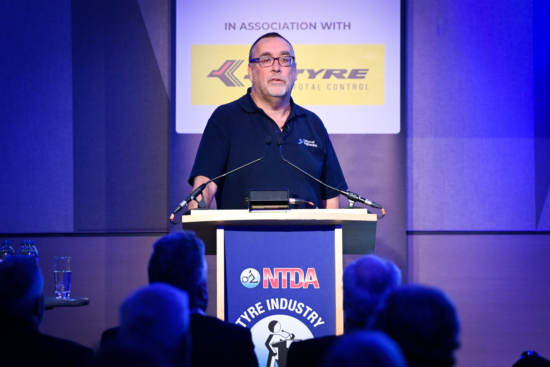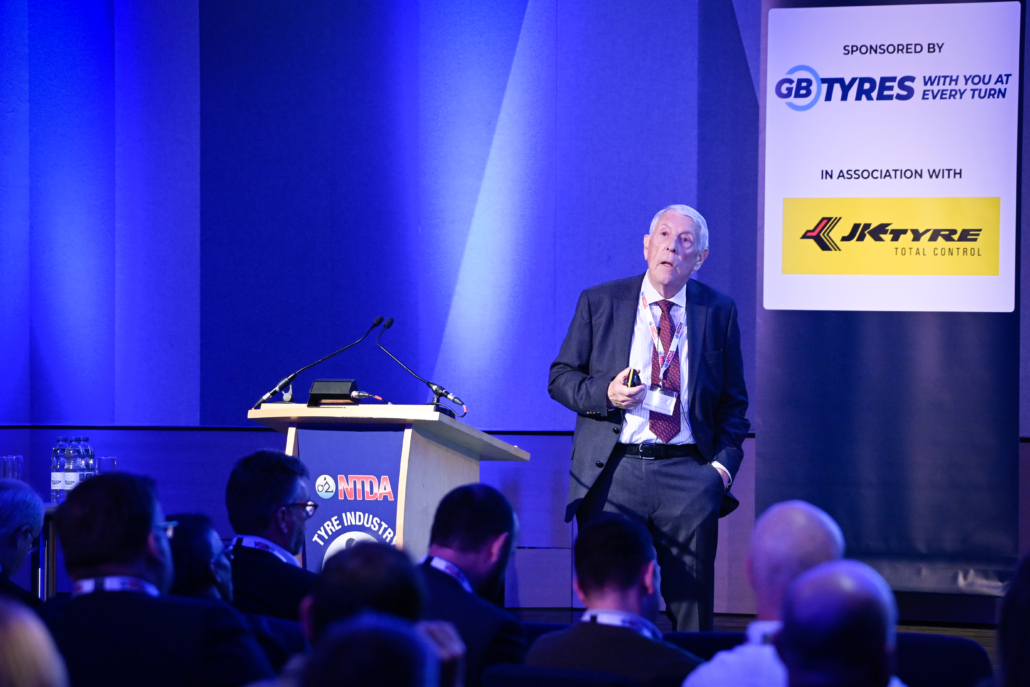The power and responsibility of tyre distribution – key sessions in the 2022 Tyre Industry Conference
 National Highways’ Mark Cartwright the commercial heads up the vehicle incident team (Photo: NTDA)
National Highways’ Mark Cartwright the commercial heads up the vehicle incident team (Photo: NTDA)
The National Tyre Distributors Association (NTDA) Tyre Industry Conference has developed a reputation for assembling top-flight speakers to address the key issues of the day. The 2022 event was no different. Topics included tyre distributors’ role in highway safety as positive influencers, part worns and market surveillance as well as tyre recovery.
After a timely session addressing AFCAR’s efforts in bringing together aftermarket interests to combat a closed-system scenario, the next session moved onto the subject of “Safer Roads” with Mark Cartwright of National Highways who heads up the commercial vehicle incident team.
By way of introduction, Cartwright explained that the success of National Highways is judged by a single metric – the number of people killed and seriously injured each year. This crucially important data, which is often abbreviated to KSI, is something National Highways work with industry and commercial organisations in order to achieve reduce as much as possible.
Here, tyre distributors in general and the NTDA in particular have “massive power” and “massive influence”, Cartwright explained, tipping his hat to the action hero Spiderman: “with massive power…comes massive responsibility”. In order for tyre distributors to be their own kind of highway heroes, NTDA members in particular have the opportunity to be exemplars in terms of health and safety best practice on the road.
Looking at accident causation, comparatively few are caused by mechanical failure. The vast majority are caused by an individual making a mistake of some kind. With that truth in mind, Cartwright went on to illustrate what is happening on strategic road network every day of the year – human beings make mistakes. “What is on drivers’ minds?”, Cartwright asked, continuing: “Is everyone a good driver? How does their relative skill, experience, boredom, attention, fatigue and mood contribute to road safety?”
Shifting approaches to part-worns
Next up, Chris Lowe, from the Driver and Vehicle Standards Agency’s (DVSA) market surveillance unit (MSU) – an entity set up in the wake of VW’s emission scandal – stepped up. The DVSA MSU is funded by the government’s Department for Transport (DfT) and carries out investigations into non-compliance in the automotive industry, with the power to enforce product recalls.
And that’s where the tyre industry comes in. MSU is running a part worn tyre programme, which represents one of 14 investigations underway. Within that, they are specifically looking at online part worn tyre sales and not those that come from vehicle breakers since those generally carry a disclaimer that tyres have not been checked.
Since part worns are legal, the goal is compliance rather than dissuasion. Indeed, from Lowe’s point of view, “Part worn tyres are waste product as soon as they come of a vehicle.” And, perhaps controversially, Lowe pointed out the view that a compliant part worn with 6mm of tread could be seen as a greener option than a new tyre.
Nevertheless, compliance investigations have been up-and-running for the last year or so. Between August 2021 and July 2022, eight mystery shopping exercises were undertaken. Five more are planned before the end of the current financial year.
The investigation visited 109 premises and 82 tyres were purchased. The surveillance unit investigators found that 70 tyres were not properly marked. And nine tyres were over 10 years old!
If that wasn’t bad enough, three had objects piercing the tyre and others had deep cut in tread. Other serious problems included having a perished outside sidewall, an abnormal – and judging by the pictures this was a seriously abnormal bulge – plus non-compliant string repairs were found.
Indeed, things were so bad that, in the case of the objects embedded in the tyre, the tyre in question bore chalk markings highlighting the problem and yet was still sold to the consumer.
In addition to this particular campaign, DVSA MSU has done tyre labelling “broad market surveillance”, mystery shopper exercises, and unannounced visits. MSU has also been lab testing wet grip and rolling noise across budget to premium. In this area the key question is: Are they displaying the correct values on the label? If not, the authorities are engaging with manufacturers to correct inaccuracies.
Developments in tyre recovery
The final morning session saw Tyre Recovery Association chair, Peter Taylor OBE update delegates about the latest development in the tyre recovery sector.
Since TRA was founded roughly 20 years ago, much has changed. Not least that there is now real market energy and enthusiasm relating to tyre recycling. So, with that in mind, what’s on the horizon? Firstly, the end of T8 exemptions, but then there’s: the Environment Agency targeting exempt operators; India introducing producer responsibility; and the impact of higher operating costs.
Furthermore, the Environment Agency (EA) is likely to introduce a new two-tier permitting system plus a technical competence element. That means only those who reach that level will be able to handle waste produced by their business. The EA is also set to introduce the role of “waste controller”, assuming legal responsibility for classifying waste and for deciding where it is taken and by whom. Meanwhile, Defra is consulting on mandatory digital waste tracking. This means that waste will require unique identifiers. So far, there are no specific provision for tyres as “itemised waste”. The forthcoming changes will require basic information to be provided on volumes and weights.
Information required includes: ho generated it; Waste description; Carrier/broker details; Movement dates (perhaps down to hour or day); Waste destruction details (what happened?); Carrier registration details; Waste volumes; Waste destinations; and strict reporting timeframes.
The focus is understood to be “the point of ‘arising'”, where the tyre comes off the wheel. Together with the TRA “retailers and dismantlers will be in the vanguard”, according to Peter Taylor.
“We must participate and engage with the process so as not to be dominated by the agenda. One-size fits all doesn’t work for everyone, therefore we need to argue for a waste tracking programme that works”, Taylor explained.
During the subsequent question and answer session, airtime was dominated by questions relating to part-worn tyres. And specifically: “While EA is imposing better waste tracking, containers of tyres are shipped into the country for sale as part worns, but neither compliant with UK regulations nor designated and handled as waste. Can anything be done?”
On a slightly different tack, part worns account for around 10 per cent of the market. Of these, mystery shopping shows it is “pot luck” whether tyres are compliant or not.
However, there is some evidence that in some cases part worn dealers are becoming more compliant. In response, one counter question from an independent tyre dealer asked, if efforts are made to raise awareness, isn’t that tantamount to tipping off part worn dealers?
At this point NTDA chief executive, Stefan Hay reluctantly pointed out: as enforcement becomes better and more proactive, we as an industry may have to face the reality of a regulated and enforced part worn market. “We have to keep safety at the forefront, stop illegal supply, stop the sale of untested, unmarked part worns. That will put most out of business”, he further explained.
The Q&A and the morning session as a whole concluded with a possible solution that technology such as RFID offers the chance to track tyres throughout their whole life. One delegate, who admittedly represented a RFID chip-related company, explained that the technology is there, but manufacturers will have to cooperate on standards and systems in order to implement it. But, as the earlier AFCAR session hinted, data relating both to general driving conditions and to personal driving habits is of great value to the industry and to society at large. And so, moving forward, it would be wise for the tyre business – which as we all know oversees the only automotive point of contact with the road and thus with gathering road data – to increasingly leverage its piece of the big data pie.
Peter Taylor OBE described how forthcoming waste management rule changes will affect the tyre business (Photo: NTDA)


 Michel Bossart; Pixabay
Michel Bossart; Pixabay
Comments